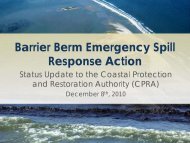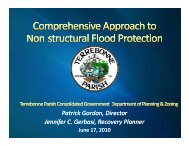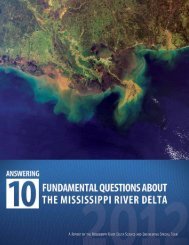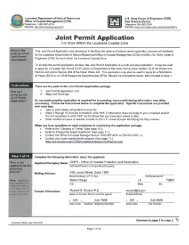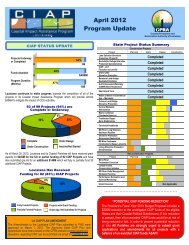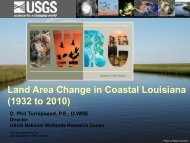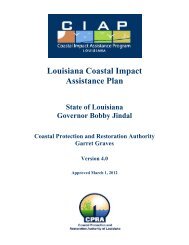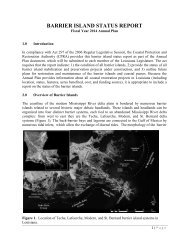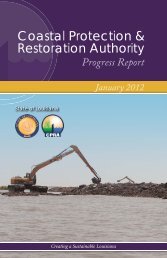Largemouth Bass Habitat Suitability Index Technical Report
Largemouth Bass Habitat Suitability Index Technical Report
Largemouth Bass Habitat Suitability Index Technical Report
You also want an ePaper? Increase the reach of your titles
YUMPU automatically turns print PDFs into web optimized ePapers that Google loves.
APPENDIX D‐9 LARGEMOUTH BASS HABITAT SUITABILITY INDEX TECHNICAL REPORT6. Suggested model improvementsInclusion of water depth and dissolved oxygen data would have greatly improved model predictions.As mentioned in Section 5, the model does predict largemouth bass in open waters that they areunlikely to use. In other words, the model has that potential for Type I errors in incorrectlyidentifying suitable habitat. However, as mentioned in Section 5, interpretation of model outputcould address this shortcoming. Further, it is possible that although freshwater diversions lowersalinity, the same inputs could lower dissolved oxygen. Potentially, largemouth bass could then belimited by dissolved oxygen, despite adequate conditions in other variables, which would result inType I model error. This error would be much more difficult to address in the current output. Theauthor suggests inclusion of these variables as inputs in future modeling efforts.7. Quality reviewSpecific QR procedures for the <strong>Largemouth</strong> <strong>Bass</strong> HSI module to support the 2012 Coastal MasterPlan included comparison of modeled predictions with expected outcomes given the known inputs.The modeling team used known spatial patterns and temporal patterns in input to predict patternsin habitat quality for each of the species8. Uncertainty analysisDetails regarding the uncertainty analysis for this model is available in Appendix D‐27 ModelUncertainty Analysis. This analysis examined the decision rules for each model variable. As well,additional model runs were performed on original and modified decision rules for the variables.Specifically, decision rules for variables SI 1 (emergent vegetation) and SI 6 (submersed aquaticvegetation) were modified during the uncertainty analysis.9. ReferencesBuisson, L., L. Blanc, and G. Grenouillet. 2008. Modeling stream fish species distribution in a rivernetwork: The relative effects of temperature versus physical factors. Ecology of Freshwater Fish 17:244‐257.Chick, J.H., C.R. Ruetz III, and J.C. Trexler. 2004. Spatial scale and abundance patterns of large fishcommunities in freshwater marshes of the Florida Everglades. Wetlands 24: 652‐664.Constant, G.C. 1990. Genetics and growth of largemouth bass in thirteen Louisiana lakes. M.S.Thesis, Louisiana State University, Baton Rouge.Davies, S.P. and S.K. Jackson. 2006. The biological condition gradient: A descriptive model forinterpreting change in aquatic ecosystems. Ecological Applications 16: 1251‐1266.Fries. 2010. Introgression, health, and condition of Florida, Northern, and Fx Hybrid <strong>Largemouth</strong><strong>Bass</strong> in Louisiana Water Bodies. M.S. Thesis. Louisiana State University, Baton Rouge.Garvey, J.E., R.A. Stein, R.A. Wright, and M.T. Bremigan. 2002. Exploring ecological mechanismsunderlying largemouth bass recruitment along environmental gradients. Pages 7‐24 in Phillip, D.P.and M.S. Ridgeway, editors. Black <strong>Bass</strong>: Ecology, Conservation, and Management. AmericanFisheries Society, Symposium 31, Bethesda, MD. 724 pp.Louisiana’s Comprehensive Master Plan for a Sustainable CoastPage 15



